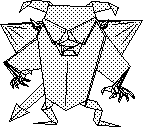
(Jun Maekawa's Devil, folded from one square of paper, no cutting)
Here are some assignments:
ASSIGNMENT 1
Due Jan. 31
ASSIGNMENT 2
Due Feb. 14
ASSIGNMENT 3
Due Feb. 21
ASSIGNMENT 4
Due March 5
ASSIGNMENT 5
Due March 26
ASSIGNMENT 6
Due April 4
ASSIGNMENT 7
Due April 11
ASSIGNMENT 8
Due April 18
ASSIGNMENT 9
Due April 25
Here are some handouts:
(all are in PDF format)
Handout 1
Handout 2
Handout 3
Handout 4
MA 323A Combinatorial Geometry!
Notes on Planar Graph Theory
Notes on how to do Proofs!
Notes on spherical Buckyballs Part 1 and Part 2
Notes on Graph Colorings
Notes on Spherical and Convex Polyhedral Geometry
Notes on Axiomatic Origami Constructions
Notes on Flat Origami Models
Notes on Making Modular Origami Tori
Notes on Linear Transformations (Reflections are Foldings, Part 1)
Notes on Reflections are Foldings, Part 2
Hi! This page was developed in the Spring of 2000 for the course Combinatorial Geometry at Merrimack College. It is currently being revised and updated for the Spring 2002 offering of this course. Below is a draft of the syllabus.
Combinatorics (the mathematics of counting) and geometry have many strong connections. We will explore these connections by looking at 3D polyhedral geometry and the mathematics of paperfolding (origami). In particular, we'll cover...
Convex Polyhedral Geometry: construction of paper models, Euler's Formula,
planar duality, coloring theorems, Hamilton cycles, Buckyball classification
and edge coloring, spherical geometry, solid angles, Descartes' Theorem,
surfaces of higher genus, convex polytopes, simplices, the Generalized Euler's
Formula.

Axiomatic and Analytic Modelling of Paper Folding: The classic straight-edge and compass axioms, origami axioms, analytic paper folding, constructing divisions of the square, trisecting angles, envelopes of curves, solving cubic equations, Haga's Theorem.
Combinatorial Modelling of Paper Folding: Maekawa's Theorem, Kawasaki's Theorem, local and global conditions for flat-foldability, NP-completeness, counting foldings, 3D solid paper folding, twists and origami tessellations, the Rabbit-Ear Theorem and origami design, isometries of the plane, high-dimensional flat folding.
There are no math books out there (yet!) that cover this material, so there will be no text for the course. This means that you all will have to take very good notes! To help, I will try to put important definitions, pictures, notes, and things on this web page, so be sure to visit frequently!
More to come!
Last Updated, 4/7/02